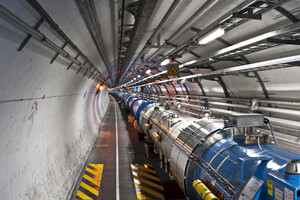Ten years ago, particle physicists stirred up the world. On July 4, 2012, 6,000 researchers working with the world's largest atomic accelerator, the Large Hadron Collider (LAC), at the European Laboratory for Particle Physics, CERN, announced that they had discovered the Higgs boson.

Higgs boson – massive particle, which is the key to explaining how other elementary particles find mass. This discovery confirmed the prediction of 45 years ago and proved the correctness of the so-called Standard Model.
And then – nothing. Physicists are concerned that the HAC is able to generate only Higgs bosons, without giving any idea of what lies beyond the standard model, writes Science. “It's a little disappointing,” admits Barry Berisch, a physicist at the California Institute of Technology. “I thought we'd discover supersymmetry that would push the boundaries of the standard model.”
It's too early to despair, many physicists say. After 3 years of modernization, the HAC is currently being launched for the third of five scheduled launches, and a new fraction may be born in the billions of proton-proton collisions it will produce every second. In fact, the Higher Attestation Commission should work for another 16 years and with further upgrades should collect 16 times more data than is already available. All of these data may reveal subtle signs of new particles and phenomena. However, some researchers say collider physics is on the verge of collapse. “If they don't find anything, the field is dead,” said Juan Collar, a physicist at the University of Chicago who is searching for dark matter. John Ellis, a theorist at King's College London, says hopes of a sudden breakthrough have given way to a long and uncertain path to discovery.
Since the 1970s, physicists have been trying to go beyond the Standard Model. It consistently describes everything that scientists have observed on particle accelerators. However, it cannot be the ultimate “theory of everything.” The standard model does not explain the nature of gravity and assumes the existence of mysterious dark matter, which is six times superior to ordinary matter in the universe.
VAK had to get out of this impasse. In its ring, protons circulating in opposite directions collide with energy almost seven times the energy of any previous collider, which allows the HAC to produce very massive particles. Ten years ago, many physicists speculated that they would quickly discover miracles, including new interacting particles or even mini-black holes. But the Higgs boson was not expected to be discovered so quickly.
Instead, the Higgs boson appeared in a relatively short 3 years. But 10 years after this monumental discovery, no new particles have appeared. Only – irritating anomalies, small discrepancies between observations and predictions of the Standard Model …
Large Hadron Collider, abbreviated BAK – charged particle accelerator on counter beams, designed to disperse protons and heavy ions and study the products of their collisions. The collider was built at CERN (European Council for Nuclear Research), located near Geneva, on the border of Switzerland and France. VAK is the largest experimental facility in the world. Its diameter is about 27 km.




